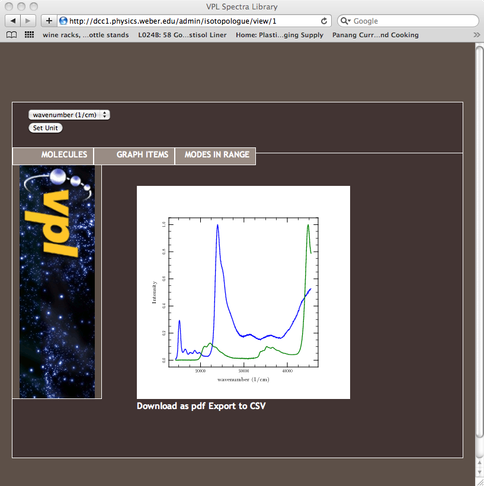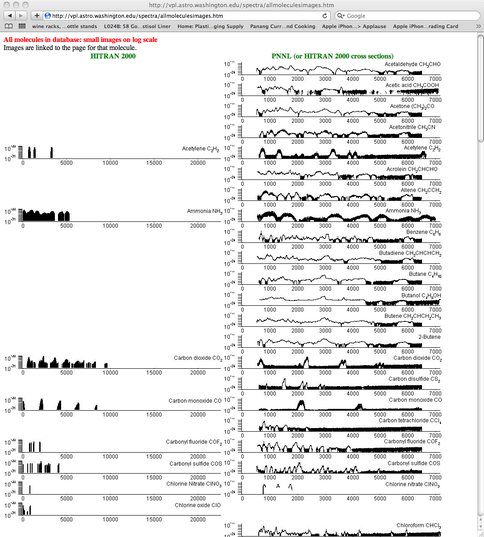2009 Annual Science Report
 VPL at University of Washington
Reporting | JUL 2008 – AUG 2009
VPL at University of Washington
Reporting | JUL 2008 – AUG 2009
VPL Databases, Model Interfaces and the Community Tool
Project Summary
The Virtual Planetary Laboratory develops modeling tools and provides a collaborative framework for scientists from many disciplines to coordinate research on the environments of extrasolar planets. As part of this framework, the VPL acts as a central repository for planetary models and the inputs required to generate those results. Developing a comprehensive storehouse of input data for computer simulations is key to successful collaboration and comparison of the models. As part of the on-going VPL Community Tools, we have are developing a comprehensive database of molecular, stellar, pigment, and mineral spectra useful in developing extrasolar planet climate models and interpreting the results of NASAs current and future planet-finding missions. The result, called the Virtual Planetary Spectral Library, will provide a common source of input data for modelers and a single source of comparison data for observers.
Project Progress
The Virtual Planetary Laboratory develops modeling tools and provides a collaborative framework for scientists from many disciplines to coordinate research on the environments of extrasolar planets. As part of this framework, the VPL acts as a central repository for planetary models and the inputs required to generate those results. Developing a comprehensive storehouse of input data for computer simulations is key to successful collaboration and comparison of the models. As part of the on-going VPL Community Tools, we have created a comprehensive database of molecular line lists, model stellar spectra, and photosynthetic pigments useful in developing extrasolar planet climate models and interpreting the results of NASA’s current and future planet-finding missions. The result, called the Virtual Planetary Spectral Library, provides a common source of input data for modelers and a single source of comparison data for observers. Over the last year, we have implemented the following tools into the Virtual Planetary Spectral Library:
- Updated comprehensive “Quick-look” HITRAN data products to be posted to the VPL website. The Virtual Planetary Laboratory currently houses a line list database of biologically interesting molecules. This database is built from the HITRAN 2004 data and has been augmented with other experimental data. A complete list of the current database can be found on the VPL website (http://vpl.astro.washington.edu/spectra/). We have extensively updated these data with the HITRAN 2008 database and are in the process of replacing the data on this site.
- New “Spectral Database Explorer”. The team has built a new database explorer than allows users to overplot HITRAN data with other astrobiologically interesting spectra. The database of biological pigments contains 22 entries along with the HITRAN data. The database tool is flexible enough to handle any spectra, including mineral and stellar spectra, as well as modeled spectra for both stars and planets. The tools are currently being ported over to a production server to be made available to the larger astrobiology community.
This tools allows users to examine and overplot HITRAN spectra or pigment spectra.
Available on the VPL website are a host of quick-look data products for the HITRAN database. We are currently in the process of updating those data with the new HITRAN 2008 data.
Publications
-
Rothman, L. S., Gordon, I. E., Barbe, A., Benner, D. C., Bernath, P. F., Birk, M., … Vander Auwera, J. (2009). The HITRAN 2008 molecular spectroscopic database. Journal of Quantitative Spectroscopy and Radiative Transfer, 110(9-10), 533–572. doi:10.1016/j.jqsrt.2009.02.013
-
Swain, M. R., Tinetti, G., Vasisht, G., Deroo, P., Griffith, C., Bouwman, J., … Angerhausen, D. (2009). WATER, METHANE, AND CARBON DIOXIDE PRESENT IN THE DAYSIDE SPECTRUM OF THE EXOPLANET HD 209458b. The Astrophysical Journal, 704(2), 1616–1621. doi:10.1088/0004-637x/704/2/1616
- Kiang, N.Y., Armstrong, J.C., Brown, L.R. & Meadows, V.S. (2009). The Virtual Planetary Laboratory Spectral Library: a community database of stellar, molecular, mineral, and biological pigment spectral properties for astrobiology research. 2nd HyspIRI ScienceWorkshop. Pasadena, CA.
-
PROJECT INVESTIGATORS:
-
PROJECT MEMBERS:
Victoria Meadows
Co-Investigator
Shawn Domagal-Goldman
Collaborator
-
RELATED OBJECTIVES:
Objective 1.1
Formation and evolution of habitable planets.
Objective 1.2
Indirect and direct astronomical observations of extrasolar habitable planets.




